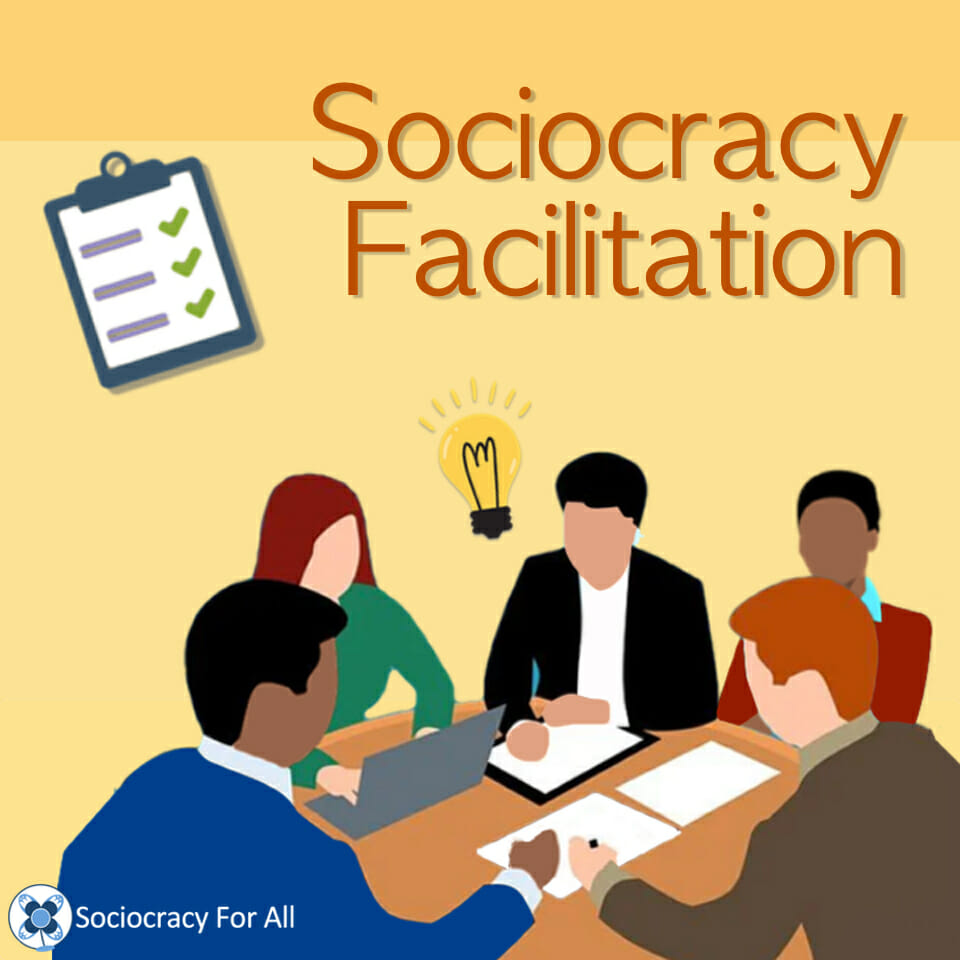Language: Italiano
Simple steps to facilitate a better meeting.
The best system does not help if we can’t do it in our groups. How can we facilitate a meeting while keeping our teams on track?
I assume that we’re talking about a scenario where the group has been trained on process. As colleague Jerry Koch-Gonzalez says: sociocracy depends more on good followers than on good facilitators. Culture training does not change overnight, and none of us have grown up in non-coercive systems. It takes practice and more practice to replace our internalized coercive patterns by non-coercive, truly collaborative ones. If you are in an inexperienced group, or want to facilitate a meeting but do not know where to start, you might checkout our introductory courses.
So, let’s say you facilitate a regular meeting where everyone has received some basic training. The group still has a tendency of getting off track — which basically describes any group. What can you do to gain more clarity for understanding, exploring and deciding together?
1. Comprehensible and transparent meeting structure
In our handbook, Many Voices One Song, we establish a typology of agenda items that can be combined in a modular way: each conversation has, at any given moment, one of these aims:
- creating a shared understanding of a report (understand phase)
- generating ideas for mutual understanding (explore phase)
- making a shared decision (decide phase)
For each of those phases, the steps to take are predictable:
- For the understand phase, we ask for a report, for clarifying questions that are then answered.
- For the explore phase, we give a prompt and then gather reactions
- (typically in a reaction round).
- In the decision phase, after establishing clarity and quick reactions, we do a consent round and address objections in an orderly way.
If every participant in a meeting has been trained on those steps and there is clarity on the aim of the conversation in every moment, then the only thing the facilitator has to do is start the rounds and check whether the group is ready for the next step. Then, facilitating a meeting feels light and productive.
My typical joke is that if, at any given time during the meeting, the facilitator drops dead, it should be possible to just continue the meeting with any other member filling in — because the phases and steps are clear and everyone knows how they build and follow each other.
Learning groups might choose to visualize those phases, definitely write them on the agenda, and that way everyone knows what is asked from them. It will be easy to understand when it is a good time for a question, for an opinion, for an objection, and everyone will know that there will be a time to be heard with that. No stress, maximum effectiveness, not sideways or backwards.
“If, at any given time during the meeting, the facilitator drops dead, it should be possible to just continue the meeting with any other member filling in…”

Study meeting facilitation:
2. Facilitator steering
Of course, every circle member might forget and offer an opinion when all that was asked for was clarifying questions, or might take the group on a tangent. And that’s ok. It happens. Heck, I teach people how to facilitate meetings, and sometimes I get carried away. To me that’s just human and a sign of me being passionately invested in the topic.

However, we want to spend our time intentional and that means, we might need
some gentle steering. How do we do that?
First of all, don’t correct people. Don’t ignore their input. Move from a facilitation style of “no, you can’t say that“ to “let’s hold that thought until”. For example instead of saying “That was an opinion and you’re only allowed to give clarifying questions right now”, try the following options:
- “I was asking for clarifying questions and this sounds like an opinion to me. Are you willing to hold it until we’ve shifted our attention to opinions and we’re ready to take in what you have to say?”
- “Right now I am trying to make sure everyone understands the proposal. Let’s write it among the opinions so we don’t forget this important piece. (write it down) Let’s go back to clarifying questions, though.”
The message has to be: I value what you have to say, and it will be easier to make use of your offering at a later time. For all of those, of course, only say it when you mean it. Don’t parrot, it’ll come across as passive-aggressive.
The by far best version is to explicitly ask for a shared agreement. For example like this “I am aware that we’re all still learning this process and it’s easy to get carried away or to fall of the bandwagon. I’d be interested in being reminded when that happens. How do people feel about gentle reminders to help each other be productive about our process and our meeting time?” Ideally, you’d make a consent decision on a specific proposal on how you’d like to be brought back on track.
The whole thing only works when we go through the process orderly, of course. If no one knows what the process is, there is no steering. If there is no order and people actually have to fear not being heard (because the group has dropped the ball too often), then they will not be able to have trust in the process — they will insist on saying what they have to say without waiting. Make sure to be accountable to your own inclusive process so you can give everyone their voice so everyone can relax and know they will be heard.
“First of all, don’t correct people. Don’t ignore their input. Move from a energy of ‘no, you can’t say that’ to ‘let’s hold that thought until’ “.
3. Fill-in-the-blank statements and facilitator role modeling
If you have clarity on your desired outcome of a round, you can use fill-in-the-blank statements. For example, it can help to offer “What I need to know to understand the proposal is…” helps start on clarifying questions (and discourages opinions). Reactions and opinions typically come naturally to people but they can be introduced by saying something like “What comes up for me around this proposal is…”
For consent rounds, I as facilitator only allow clear statements of consent or objections in one sentence — not long-winded, vague statements.
There is also a lot of power in role-modeling decision making. For example, instead of complaining about your group, ask for clarity: “Sorry but I am confused and I’d like to understand where we are in the process right now because then I’ll know how to contribute best. Are we in the understand phase, in the explore phase or is this about making a decision?”
Offering clarifying statements helps build up a group’s understanding of the process, making more members feel comfortable enough to facilitate a meeting in the future.
I have made it a habit to use formulaic language during some parts of the meeting. For example, I tend to say “I have no objection to the proposal” when I consent, just to remind people that not having an objection is good enough. Or, in a clarifying questions round, I say “I understand the proposal as stated” to emphasize that whether or not I understand is the only thing that’s asked of me at that moment.
Want to help improve these articles?

To Recap:
- Staying on track is a group effort, not facilitator effort. If it is hard to keep the group on track when you facilitate a meeting, then the group needs additional training and clarity.
- As facilitators, we’re not solely responsible, and the clarity and shared responsibility that sociocracy offers is a great way out of the savior-syndrome that facilitators can easily fall into.
- On the flip side, groups are better off if they request and maintain clarity over process so they can contribute in their most productive way, while managing time well.



Leave a Reply
You must be logged in to post a comment.